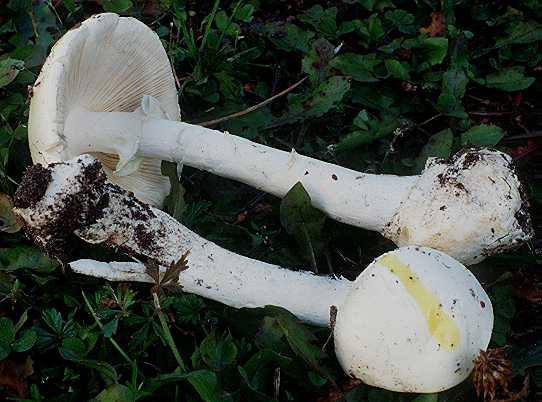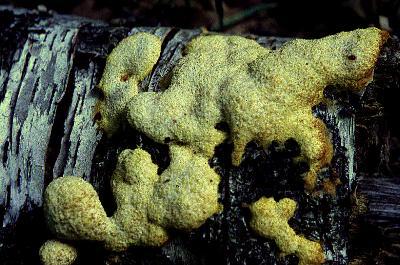 Q. Can I eat it?
Q. Can I eat it?
For the rest of my pages on fungi, please click http://TomVolkFungi.net
I get so many emails every month that the questions have started to repeat themselves. repeat themselves. So I decided to answer some of these Frequently Asked Questions.
A. Probably not. Of the 70.000 species of fungi about 250 species are considered good delicious edibles. Another 250 species can kill you-- or at least make you wish you were dead. Everything else is something in between-- from some that are "sort of ok tasting if there's nothing else to eat and you're starving in the woods" to some that are "just too bitter or taste too bad to eat," or some that are too small or too tough to eat or that have something else wrong with them.
Q. I'm interested in learning more about mushrooms and other fungi in my area. Where can I turn to for help?
A. You're in luck. There are nearly 100 societies and clubs for amateur mycologists in all areas of the country. If you're in North America you can find a club near you here. Does anyone know of a similar list for the rest of the world?
If you're interested in Mycology as a profession or are interested in what professional mycologists are up to, I highly recommend visiting the home page of The Mycological Society of America for information on Mycology in North America and lots of links to interesting places in Mycological Cyberspace. I am the webmaster for that page also.
Q. I have lots of mushrooms in my yard and I hate them! What can i do to get rid of them?
A. You probably won't get much sympathy from a mycologist-- or anyone else who knows about mushrooms. Most of these mushroom are good for our yard, degrading waste products and returning them to the soil. Even more important are the mushrooms that are associated with trees as mycorrhizae. Without this mutualistic association most trees would not survive. Killing these fungi would effectively kill your trees.
 Q. ... but what about the fungi growing in my bark mulch or wood chips? Can I get rid of those?
Q. ... but what about the fungi growing in my bark mulch or wood chips? Can I get rid of those?
A. Most of these fungi are near impossible to get rid of without completely replacing the mulch and paving over the yard. I recommend you read more of my pages and find some way to enjoy the fungi in your yard. Show them off to your friends. Cultivate a fungus garden. Wouldn't it be nice to be able to show off something unusual in your yard?
Read what http://www.lesslawn.com has to say about mushrooms in your lawn.
Q. I have some things sticking up in my wood chips that look like upside-down carrots dipped in mud. They smell really bad, like rotting meat, and they're attracting flies. My husband says they look like an embarrassing part of a dog's anatomy. What are these?
A. Sounds like you have the dog stinkhorn. See my stinkhorn page here
 Q. Could you kindly help us identify the fungus/fungi growing in our flower bed? What we first thought was our dog's -- well, to put it bluntly-- vomit, seems to be some kind of living, thriving fungal entity. This patch of muted golden-colored "whatever" seems to thrive in the cypress mulch-filled, wooden-bordered landscaping. What is it? --and how can I get rid of it?
Q. Could you kindly help us identify the fungus/fungi growing in our flower bed? What we first thought was our dog's -- well, to put it bluntly-- vomit, seems to be some kind of living, thriving fungal entity. This patch of muted golden-colored "whatever" seems to thrive in the cypress mulch-filled, wooden-bordered landscaping. What is it? --and how can I get rid of it?
A. It sounds like the dog vomit slime mold. Fuligo septica. See this page for more information.
Q. I think I'm getting sick from inhaling the mold spores in my house/ attic/ apartment/ dorm/ office/ lab. What should I do about it?
There are some fungi known to cause allergic reactions in many people-- you've all seen the mold count listed right there along with the pollen count on the weather channel. your best bet for avoiding mycoallergies is to keep the offending area dry. Fungi need water to grow. If you already feel sick, see my answer to the next question. You can also read my page about Stachybotrys chartatum.
Q. I think I'm getting a rash from a fungus. Plus I think I have a fungal lung infection. I may be allergic to mold spores. What should I do?
A. I'm sorry I'm not a medical doctor and I'm not qualified to comment on this. Please do not write to me with your medical problems. Please see a medical doctor. PLEASE do not send me bags of the fungi you think are causing your problems or bring me bottles of molds. (this has happened to me more than once...)
Q. Everywhere I go now I see mushrooms and other fungi. And I've been hearing a lot about fungi on the news. How can fungi be so prevalent in the environment?
A. Fungi are very successful organisms because of the genetic plasticity and physiological versatility. Many produce large numbers of spores that can be spread everywhere through the air. Fungi can degrade just about anything we humans can make, with the exception of some plastics and some pesticides. Fungi can penetrate even the toughest substrates with the exoenzymes produced by their hyphae. Exoenzymes are found in fungi and some bacteria. They are digestive enzymes that are secreted into the environment, where they digest the food into small molecules that can be absorbed and used by the fungus.
 Q. I've heard about a large fungus growing underground in Michigan and a couple other large fungi in western states. Can you tell me more about this?
Q. I've heard about a large fungus growing underground in Michigan and a couple other large fungi in western states. Can you tell me more about this?
A. The fungi are all members of the genus Armillaria, which has become famous for its large clonal size. The original "humongus fungus" was a 37 acre underground mycelium of Armillaria gallica found in the Upper Peninsula of Michigan (Smith , M., J. Bruhn and J. Anderson, 1992. The fungus Armillaria bulbosa is among the largest and oldest living organisms. Nature 356:428-431) and was reported on the front page of the New York Times and most other papers in this country in April 1992. The furor was intensified when a few weeks later some other researchers claimed they had a 1500 acre mycelium of Armillaria ostoyae in Washington State. In summer of 2000 another set of researchers claimed they had a larger fungus (2500 acres?) in the Malheur National Forest in eastern Oregon.
See this page on the Tenth Anniversary of the Humongous Fungus.
This sparked an intense debate over whose fungus was larger and sparked an even larger debate over "what is an organism?" Should we consider the large clones of aspen originating from a single tree a single organism? These questions remain unresolved.
Q. While splitting some wood in the evening, a friend of mine found some bioluminescent fungi (of course, at the time he did not know what it was). We live on Long Island, NY, and would like to know more about this fungi, also known as 'foxfire'. We've already read what the encyclopedia Britannica has to say about it. Any suggestions?
A. Most foxfire is caused by Armillaria species. Here's a link to something Elio Schaechter wrote about foxfire in his marvelous book "In the Company of Mushrooms" (Harvard University Press; ISBN: 0674445546).
I was recently interviewed on the radio by EdmontonAM of the Canadian Broadcasting Corporation about foxfire-- bioluminescent glowing logs caused by Armillaria species. You can hear the interview here. Scroll down to "why is my firewood glowing?" on that page.
You can also read an article from USA Today here, where I was interviewed about foxfire.
Q. Is that fungus you're standing with in Vermont on your web page real?
Well, it's real *cement* --- does that count? It's a statue in a park overlooking Lake Champlain in Burlington VT. On the other side was sculpted a small elf. There's many layers of paint scraped off of the mushroom. I think it may have been painted in psychedelic colors during the 1960's and 70's. The largest fungal fruiting bodies known are much smaller than that, only about 300 lb. All the largest fruiting bodies are from perennial polypores, such as Bridgeoporus nobilissimus.
I'll be adding to this page as time progresses.
Do you have any suggestions for questions? Write to me at volk.thom@uwlax.edu
For the rest of my pages on fungi, please click http://TomVolkFungi.net